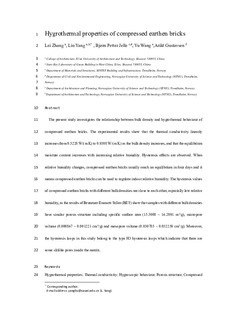| dc.contributor.author | Zhang, Lei | |
| dc.contributor.author | Yang, Liu | |
| dc.contributor.author | Jelle, Bjørn Petter | |
| dc.contributor.author | Wang, Yu | |
| dc.contributor.author | Gustavsen, Arild | |
| dc.date.accessioned | 2017-12-19T16:09:19Z | |
| dc.date.available | 2017-12-19T16:09:19Z | |
| dc.date.created | 2017-11-30T00:21:18Z | |
| dc.date.issued | 2018 | |
| dc.identifier.citation | Construction and Building Materials. 2018, 162, 576-583. | nb_NO |
| dc.identifier.issn | 0950-0618 | |
| dc.identifier.uri | http://hdl.handle.net/11250/2473088 | |
| dc.description.abstract | The present study investigates the relationship between bulk density and hygrothermal behaviour of compressed earthen bricks. The experimental results show that the thermal conductivity linearly increases from 0.5228 W/(m K) to 0.9308 W/(m K) as the bulk density increases, and that the equilibrium moisture content increases with increasing relative humidity. Hysteresis effects are observed. When relative humidity changes, compressed earthen bricks usually reach an equilibrium in four days and it means compressed earthen bricks can be used to regulate indoor relative humidity. The hysteresis values of compressed earthen bricks with different bulk densities are close to each other, especially low relative humidity, as the results of Brunauer-Emmett-Teller (BET) show that samples with different bulk densities have similar porous structure including specific surface area (15.5008–16.2091 m2/g), micropore volume (0.000867–0.001221 cm3/g) and mesopore volume (0.030785–0.032239 cm3/g). Moreover, the hysteresis loops in this study belong to the type H3 hysteresis loops which indicate that there are some slitlike pores inside the matrix. | nb_NO |
| dc.language.iso | eng | nb_NO |
| dc.publisher | Elsevier | nb_NO |
| dc.rights | Attribution-NonCommercial-NoDerivatives 4.0 Internasjonal | * |
| dc.rights.uri | http://creativecommons.org/licenses/by-nc-nd/4.0/deed.no | * |
| dc.title | Hygrothermal Properties of Compressed Earthen Bricks | nb_NO |
| dc.type | Journal article | nb_NO |
| dc.type | Peer reviewed | nb_NO |
| dc.description.version | acceptedVersion | nb_NO |
| dc.source.pagenumber | 576-583 | nb_NO |
| dc.source.volume | 162 | nb_NO |
| dc.source.journal | Construction and Building Materials | nb_NO |
| dc.identifier.doi | 10.1016/j.conbuildmat.2017.11.163 | |
| dc.identifier.cristin | 1520568 | |
| dc.relation.project | Norges forskningsråd: 245963 | nb_NO |
| dc.relation.project | Norges forskningsråd: 263919 | nb_NO |
| dc.description.localcode | © 2017 Elsevier Ltd. All rights reserved. This is the authors' accepted and refereed manuscript to the article, locked until 15 December 2019 due to copyright restrictions. | nb_NO |
| cristin.unitcode | 194,64,91,0 | |
| cristin.unitcode | 194,61,50,0 | |
| cristin.unitcode | 194,61,55,0 | |
| cristin.unitname | Institutt for bygg- og miljøteknikk | |
| cristin.unitname | Institutt for arkitektur og planlegging | |
| cristin.unitname | Institutt for arkitektur og teknologi | |
| cristin.ispublished | false | |
| cristin.fulltext | original | |
| cristin.fulltext | postprint | |
| cristin.qualitycode | 2 | |

